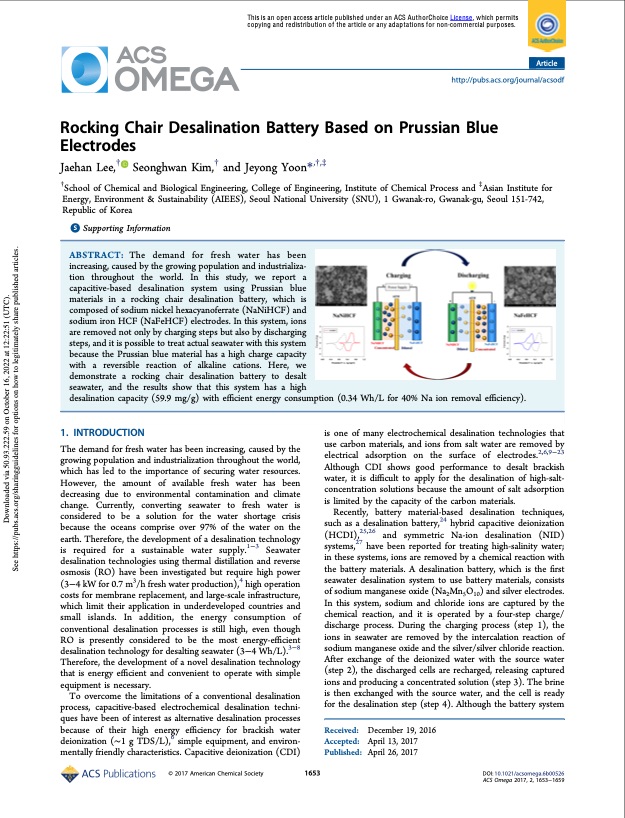
PDF Publication Title:
Text from PDF Page: 001
This is an open access article published under an ACS AuthorChoice License, which permits copying and redistribution of the article or any adaptations for non-commercial purposes. http://pubs.acs.org/journal/acsodf Rocking Chair Desalination Battery Based on Prussian Blue Electrodes Jaehan Lee,† Seonghwan Kim,† and Jeyong Yoon*,†,‡ †School of Chemical and Biological Engineering, College of Engineering, Institute of Chemical Process and ‡Asian Institute for Energy, Environment & Sustainability (AIEES), Seoul National University (SNU), 1 Gwanak-ro, Gwanak-gu, Seoul 151-742, Republic of Korea *S Supporting Information ABSTRACT: The demand for fresh water has been increasing, caused by the growing population and industrializa- tion throughout the world. In this study, we report a capacitive-based desalination system using Prussian blue materials in a rocking chair desalination battery, which is composed of sodium nickel hexacyanoferrate (NaNiHCF) and sodium iron HCF (NaFeHCF) electrodes. In this system, ions are removed not only by charging steps but also by discharging steps, and it is possible to treat actual seawater with this system because the Prussian blue material has a high charge capacity with a reversible reaction of alkaline cations. Here, we demonstrate a rocking chair desalination battery to desalt seawater, and the results show that this system has a high desalination capacity (59.9 mg/g) with efficient energy consumption (0.34 Wh/L for 40% Na ion removal efficiency). Article 1. INTRODUCTION The demand for fresh water has been increasing, caused by the growing population and industrialization throughout the world, which has led to the importance of securing water resources. However, the amount of available fresh water has been decreasing due to environmental contamination and climate change. Currently, converting seawater to fresh water is considered to be a solution for the water shortage crisis because the oceans comprise over 97% of the water on the earth. Therefore, the development of a desalination technology is required for a sustainable water supply.1−3 Seawater desalination technologies using thermal distillation and reverse osmosis (RO) have been investigated but require high power (3−4 kW for 0.7 m3/h fresh water production),4 high operation costs for membrane replacement, and large-scale infrastructure, which limit their application in underdeveloped countries and small islands. In addition, the energy consumption of conventional desalination processes is still high, even though RO is presently considered to be the most energy-efficient desalination technology for desalting seawater (3−4 Wh/L).3−8 Therefore, the development of a novel desalination technology that is energy efficient and convenient to operate with simple equipment is necessary. To overcome the limitations of a conventional desalination process, capacitive-based electrochemical desalination techni- ques have been of interest as alternative desalination processes because of their high energy efficiency for brackish water deionization (∼1 g TDS/L),6 simple equipment, and environ- mentally friendly characteristics. Capacitive deionization (CDI) © 2017 American Chemical Society 1653 is one of many electrochemical desalination technologies that use carbon materials, and ions from salt water are removed by electrical adsorption on the surface of electrodes.2,6,9−23 Although CDI shows good performance to desalt brackish water, it is difficult to apply for the desalination of high-salt- concentration solutions because the amount of salt adsorption is limited by the capacity of the carbon materials. Recently, battery material-based desalination techniques, such as a desalination battery,24 hybrid capacitive deionization (HCDI),25,26 and symmetric Na-ion desalination (NID) systems,27 have been reported for treating high-salinity water; in these systems, ions are removed by a chemical reaction with the battery materials. A desalination battery, which is the first seawater desalination system to use battery materials, consists of sodium manganese oxide (Na2Mn5O10) and silver electrodes. In this system, sodium and chloride ions are captured by the chemical reaction, and it is operated by a four-step charge/ discharge process. During the charging process (step 1), the ions in seawater are removed by the intercalation reaction of sodium manganese oxide and the silver/silver chloride reaction. After exchange of the deionized water with the source water (step 2), the discharged cells are recharged, releasing captured ions and producing a concentrated solution (step 3). The brine is then exchanged with the source water, and the cell is ready for the desalination step (step 4). Although the battery system Received: December 19, 2016 Accepted: April 13, 2017 Published: April 26, 2017 DOI: 10.1021/acsomega.6b00526 ACS Omega 2017, 2, 1653−1659 Downloaded via 50.93.222.59 on October 16, 2022 at 12:22:51 (UTC). See https://pubs.acs.org/sharingguidelines for options on how to legitimately share published articles.PDF Image | Rocking Chair Desalination Battery Prussian Blue Electrodes

PDF Search Title:
Rocking Chair Desalination Battery Prussian Blue ElectrodesOriginal File Name Searched:
rocking-chair-desalination-battery-prussian-blue.pdfDIY PDF Search: Google It | Yahoo | Bing
Product and Development Focus for Salgenx
Redox Flow Battery Technology: With the advent of the new USA tax credits for producing and selling batteries ($35/kW) we are focussing on a simple flow battery using shipping containers as the modular electrolyte storage units with tax credits up to $140,000 per system. Our main focus is on the salt battery. This battery can be used for both thermal and electrical storage applications. We call it the Cogeneration Battery or Cogen Battery. One project is converting salt (brine) based water conditioners to simultaneously produce power. In addition, there are many opportunities to extract Lithium from brine (salt lakes, groundwater, and producer water).Salt water or brine are huge sources for lithium. Most of the worlds lithium is acquired from a brine source. It's even in seawater in a low concentration. Brine is also a byproduct of huge powerplants, which can now use that as an electrolyte and a huge flow battery (which allows storage at the source).We welcome any business and equipment inquiries, as well as licensing our flow battery manufacturing.| CONTACT TEL: 608-238-6001 Email: greg@salgenx.com | RSS | AMP |